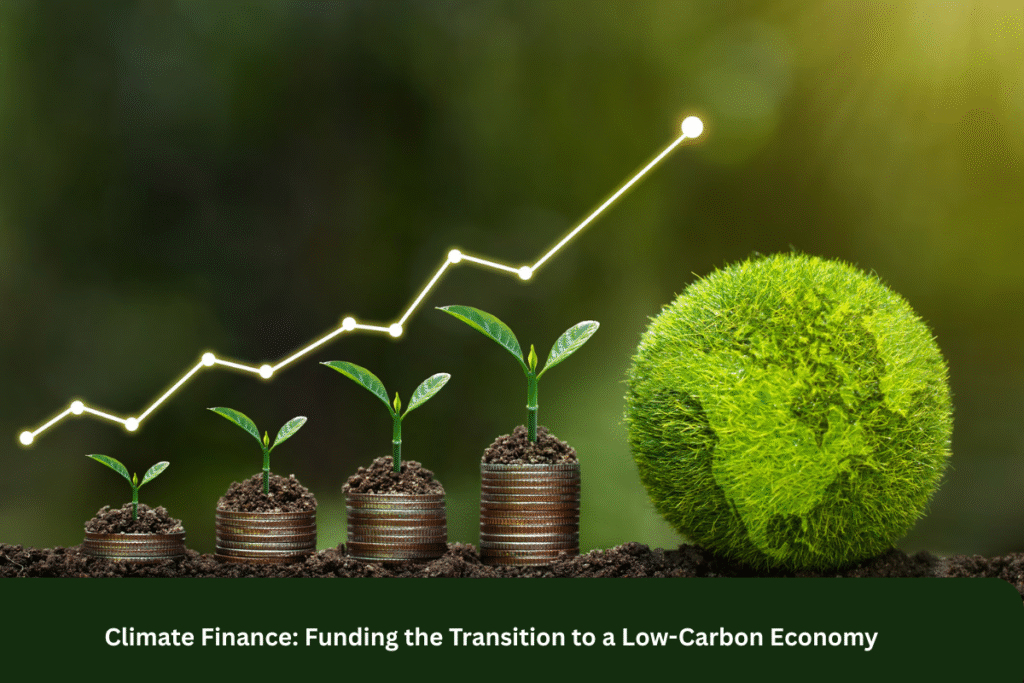
As the world grapples with the accelerating impacts of climate change, the need for a transition to a low-carbon economy has never been more urgent. Achieving this transition requires massive investment in clean energy, sustainable infrastructure, and climate adaptation strategies. This is where climate finance comes in—a critical tool for funding the shift to a sustainable future. In this article, we will explore the importance of climate finance, how it works, and its role in funding the transition to a low-carbon economy.
1. What is Climate Finance?
Climate finance refers to the financial resources allocated to projects and initiatives aimed at reducing greenhouse gas emissions and adapting to the impacts of climate change. It involves both public and private investments, including loans, grants, and equity investments, directed toward mitigating climate change and supporting the transition to a low-carbon economy.
The primary goal of climate finance is to help countries, industries, and communities reduce their carbon footprint while building resilience to climate change impacts. It plays a crucial role in meeting international climate targets, such as those set in the Paris Agreement, which aims to limit global warming to well below 2°C.
2. The Importance of Climate Finance for the Low-Carbon Economy
Transitioning to a low-carbon economy involves transforming every sector of society—from energy and transportation to agriculture and urban infrastructure. Achieving this transformation requires significant financial resources to support the development and deployment of clean technologies, sustainable practices, and climate adaptation measures.
a. Mitigation and Adaptation Funding
Climate finance is essential for both mitigation and adaptation efforts:
- Mitigation involves reducing or preventing the emission of greenhouse gases. Climate finance supports the development of renewable energy projects (e.g., solar, wind, and hydropower), energy efficiency initiatives, and sustainable transportation systems.
- Adaptation involves adjusting to the impacts of climate change. Climate finance supports infrastructure projects that help communities cope with rising sea levels, extreme weather events, and shifting agricultural patterns.
b. Meeting Global Climate Targets
In 2015, nearly 200 countries signed the Paris Agreement, committing to limiting global temperature rise to below 2°C, with efforts to limit it to 1.5°C. To meet these ambitious targets, it is estimated that global investments in climate change mitigation and adaptation must exceed $3 trillion annually by 2050. Climate finance provides the necessary funding to meet these targets and drive the global shift toward a sustainable future.
c. Economic Opportunities and Job Creation
Investing in climate solutions creates new economic opportunities. The renewable energy sector, for example, is one of the fastest-growing industries globally, generating jobs in technology, manufacturing, and maintenance. Similarly, investing in energy-efficient buildings, sustainable agriculture, and green infrastructure promotes job creation and economic growth, while reducing environmental impact.
3. How Climate Finance Works
Climate finance can be divided into two main categories: public and private finance. Both play essential roles in funding the transition to a low-carbon economy.
a. Public Climate Finance
Public climate finance refers to funding provided by governments, international organizations, and development banks. It is essential for addressing the financing gap in developing countries, where access to private capital is limited, and climate change impacts are most severe.
Key sources of public climate finance include:
- Government Contributions: Countries allocate funds to climate finance through domestic budgets, as well as through international agreements like the Green Climate Fund (GCF).
- International Financial Institutions: The World Bank, International Monetary Fund (IMF), and regional development banks provide financing for climate change mitigation and adaptation projects in developing countries.
- Multilateral Initiatives: Initiatives like the Adaptation Fund and the Global Environment Facility (GEF) support climate projects in vulnerable regions by providing grants and concessional loans.
b. Private Climate Finance
Private climate finance refers to investments made by businesses, financial institutions, and individuals in low-carbon projects and technologies. This funding is crucial for scaling up clean energy technologies and building sustainable infrastructure.
Sources of private climate finance include:
- Private Equity and Venture Capital: Investment firms provide funding for innovative clean technology startups and renewable energy projects.
- Green Bonds: Green bonds are debt instruments issued to raise funds for projects that have environmental benefits, such as renewable energy or energy-efficient buildings.
- Corporate Investments: Companies are increasingly investing in sustainability efforts, including renewable energy infrastructure, sustainable supply chains, and carbon offset programs.
c. Blended Finance
Blended finance combines both public and private funds to de-risk investments and attract private capital for climate-related projects. This approach leverages public funding to incentivize private investors to finance projects in developing countries or high-risk sectors, thus expanding the reach of climate finance.
4. Challenges in Climate Finance
While climate finance is essential for the low-carbon transition, several challenges must be addressed to unlock its full potential:
a. Funding Gap
The current level of climate finance is insufficient to meet global climate goals. According to the UN Environment Programme (UNEP), there is a funding gap of $2.5 trillion annually for developing countries to implement climate mitigation and adaptation projects. Increased funding from both public and private sectors is needed to close this gap.
b. Access to Finance in Developing Countries
Many developing countries face barriers in accessing climate finance due to factors such as lack of infrastructure, limited capacity to develop projects, and a lack of knowledge about available financing options. To ensure equity in climate finance, it is essential to improve access to funding for these countries, particularly those most vulnerable to climate change.
c. Long-Term Investment Horizon
Many climate projects require long-term financing, which can be challenging for investors seeking short-term returns. Encouraging private investment in long-term, low-carbon infrastructure requires policies that reduce risk and enhance the profitability of such investments.
5. FAQs
1. What is climate finance?
2. Why is climate finance important for the transition to a low-carbon economy?
3. What are green bonds?
4. How does blended finance work?
5. What are the main challenges in climate finance?
6. Conclusion
Climate finance is essential for funding the transition to a low-carbon economy. By supporting both mitigation and adaptation efforts, climate finance enables countries, businesses, and communities to reduce emissions, enhance resilience to climate impacts, and achieve sustainability goals. Although challenges remain in closing the funding gap and ensuring equitable access, continued investment from both public and private sectors will be crucial in scaling up the transition to a sustainable, low-carbon future. With effective climate finance, we can accelerate the global effort to combat climate change and secure a more sustainable world for future generations.
